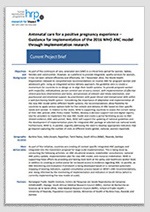Early Menstrual Induction (EMI): A proof of concept study on a post-fertilization fertility regulation method with a combination of levonorgestrel and mifepristone
HRP Project Brief

Overview
Modern contraception, that acts pre-fertilization, is the most effective method for preventing unplanned and unwanted pregnancies and subsequent maternal deaths due to unsafe abortion and other pregnancy complications. Between 4.7% –
13.2% of maternal deaths can be attributed to unsafe abortion. Unfortunately, there is still a gap in the use of contraception contributing to 73.3 million abortions between 1990 and 2019 (Bearak et al., 2020).
Emergency (postcoital) contraception offers an effective solution in cases of unprotected intercourse, if it is available and accessible within a period of 3-5 days, depending on the emergency contraceptive. Ulipristal acetate (UPA)
and the copper-bearing intrauterine device (IUD) can be used up to five days after unprotected intercourse. However, once the 5-day window has passed, the only recourse is abortion where legally permissible.
The aim of this proof-of-concept study is investigate the effects of a novel regimen of a combined progesterone (levonorgestrel) and anti-progesterone (mifepristone), to induce endometrial shedding and to prevent an intrauterine pregnancy in women who have had unprotected intercourse and missed the emergency contraception window.
